What'sNEW
September - December 2015
| 30 Dec 2015 |
What'sNEW about HGT  | | |
It is even argued that HGT has been highly active and important since the beginning of cellular life and that the complexity of life, as we know it, may not have evolved without HGT.
 Horizontal transfer of short and degraded DNA has evolutionary implications for microbes and eukaryotic sexual reproduction by Søren Overballe-Petersen and Eske Willerslev, doi:10.1002/bies.201400035, Bioessays, Oct 2014. Horizontal transfer of short and degraded DNA has evolutionary implications for microbes and eukaryotic sexual reproduction by Søren Overballe-Petersen and Eske Willerslev, doi:10.1002/bies.201400035, Bioessays, Oct 2014.
 Thanks, Tobias Mourier. Thanks, Tobias Mourier.
 Viruses and Other Gene Transfer Mechanisms is the main related CA webpage. Viruses and Other Gene Transfer Mechanisms is the main related CA webpage.
| 16 Dec 2015 |
What'sNEW about HGT  | | |
...We identified up to hundreds of active foreign genes in animals, including humans, suggesting that HGT provides important contributions to metazoan evolution.
 Expression of multiple horizontally acquired genes is a hallmark of both vertebrate and invertebrate genomes by Alastair Crisp, Chiara Boschetti et al., doi:10.1186/s13059-015-0607-3, Genome Biol. [PubMed abstract | pdf], 15 Mar 2015. Expression of multiple horizontally acquired genes is a hallmark of both vertebrate and invertebrate genomes by Alastair Crisp, Chiara Boschetti et al., doi:10.1186/s13059-015-0607-3, Genome Biol. [PubMed abstract | pdf], 15 Mar 2015.
 (Rebuttal) (Rebuttal)  Horizontal gene transfer is not a hallmark of the human genome, by Steven L. Salzberg, doi:10.1186/s13059-017-1214-2, Genome Biol., 08 May 2017.
We argue that the introduction of transposable elements by horizontal transfer in eukaryotic genomes has been a major force propelling genomic variation and biological innovation. Horizontal gene transfer is not a hallmark of the human genome, by Steven L. Salzberg, doi:10.1186/s13059-017-1214-2, Genome Biol., 08 May 2017.
We argue that the introduction of transposable elements by horizontal transfer in eukaryotic genomes has been a major force propelling genomic variation and biological innovation.
 Promiscuous DNA: horizontal transfer of transposable elements and why it matters for eukaryotic evolution by Sarah Schaack, Clément Gilbert and Cédric Feschotte, doi:10.1016/j.tree.2010.06.001, Trends Ecol Evol [abstract], Sep 2010. Promiscuous DNA: horizontal transfer of transposable elements and why it matters for eukaryotic evolution by Sarah Schaack, Clément Gilbert and Cédric Feschotte, doi:10.1016/j.tree.2010.06.001, Trends Ecol Evol [abstract], Sep 2010.
 Viruses and Other Gene Transfer Mechanisms is the main related CA webpage. Viruses and Other Gene Transfer Mechanisms is the main related CA webpage.
 The Senior Astronomer at SETI says that an apparent biological fossil on Mars can be ruled nonbiological by geologists, with no need to consult biologists, 13-15 Dec 2015. The Senior Astronomer at SETI says that an apparent biological fossil on Mars can be ruled nonbiological by geologists, with no need to consult biologists, 13-15 Dec 2015.
...The arrival of this new group [diplobasts] was accompanied by a small number of novel proteins (specified by previously nonexistent genes).... Many triploblast groups are associated with an entirely new collection of previously nonexistent proteins, mediating previously unprecedented functions. Stuart A. Newman, Professor of Cell Biology and Anatomy, New York Medical College:
 Are We Toys?, HuffPost Science, 8 Dec 2015. Are We Toys?, HuffPost Science, 8 Dec 2015.
 Thanks, Kevin Hatfield.
Standard darwinism is perplexed by genetic programs that seem to have come from nowhere. They are a basic prediction of cosmic ancestry. For example, see Thanks, Kevin Hatfield.
Standard darwinism is perplexed by genetic programs that seem to have come from nowhere. They are a basic prediction of cosmic ancestry. For example, see
 New genetic programs in Darwinism and strong panspermia. New genetic programs in Darwinism and strong panspermia.
| 7 Dec 2015 |
What'sNEW about HGT  | | |
We compare our assembly to a recently published one for the same species and do not find support for massive horizontal gene transfer.
 The genome of the tardigrade Hypsibius dujardini, Georgios Koutsovoulos et al., doi:10.1101/033464, BioRxiv, 1 Dec 2015; and commentary: The genome of the tardigrade Hypsibius dujardini, Georgios Koutsovoulos et al., doi:10.1101/033464, BioRxiv, 1 Dec 2015; and commentary:
 ...How Much Foreign DNA Tardigrades Actually Have by Victoria Turk, Motherboard, 7 Dec 2015. Later: ...How Much Foreign DNA Tardigrades Actually Have by Victoria Turk, Motherboard, 7 Dec 2015. Later:
 No evidence for extensive horizontal gene transfer in the genome of the tardigrade Hypsibius dujardini, Georgios Koutsovoulos et al., doi:10.1073/pnas.1600338113, PNAS, online 3 May 2016. No evidence for extensive horizontal gene transfer in the genome of the tardigrade Hypsibius dujardini, Georgios Koutsovoulos et al., doi:10.1073/pnas.1600338113, PNAS, online 3 May 2016.
Approximately one-sixth of the genes in the tardigrade genome were found to have been acquired through horizontal transfer....
 Evidence for extensive horizontal gene transfer from the draft genome of a tardigrade, Thomas C. Boothby, Bob Goldstein et al., doi:10.1073/pnas.1510461112, PNAS, online 23 Nov 2015. Evidence for extensive horizontal gene transfer from the draft genome of a tardigrade, Thomas C. Boothby, Bob Goldstein et al., doi:10.1073/pnas.1510461112, PNAS, online 23 Nov 2015.
 A huge chunk of a tardigrade's genome comes from foreign DNA, University of North Carolina, 23 Nov 2015. A huge chunk of a tardigrade's genome comes from foreign DNA, University of North Carolina, 23 Nov 2015.
...More than 6,600 genes ...were obtained through horizontal gene transfer from bacteria, fungi, and other organisms.
 ...Horizontally Acquired Genes in Water Bear Genome, Genome Web, 24 Nov 2015. ...Horizontally Acquired Genes in Water Bear Genome, Genome Web, 24 Nov 2015.
 Thanks, Google Alerts. Thanks, Google Alerts.
 Viruses and Other Gene Transfer Mechanisms is a related CA webpage. Viruses and Other Gene Transfer Mechanisms is a related CA webpage.
| 23 Nov 2015 |
What'sNEW about HGT  | | |
Genetic residue from ancient viral infections has been repurposed to play a vital role in acquiring pluripotency, the developmental state that allows a fertilized human egg to become all the cells in the body.
 Ancient viral molecules essential for human development by Krista Conger, Stanford Medicine (+PhysOrg.com), 23 Nov 2015. Ancient viral molecules essential for human development by Krista Conger, Stanford Medicine (+PhysOrg.com), 23 Nov 2015.
 Thanks, Stan Franklin. Thanks, Stan Franklin.
 The primate-specific noncoding RNA HPAT5 regulates pluripotency during human preimplantation development and nuclear reprogramming by Jens Durruthy-Durruthy, Vittorio Sebastiano, et al., Nature Genetics, 23 Nov 2015. The primate-specific noncoding RNA HPAT5 regulates pluripotency during human preimplantation development and nuclear reprogramming by Jens Durruthy-Durruthy, Vittorio Sebastiano, et al., Nature Genetics, 23 Nov 2015.
 Viruses and Other Gene Transfer Mechanisms is a related CA webpage. Viruses and Other Gene Transfer Mechanisms is a related CA webpage.
 Three things Rosetta taught us +3 we don't know about Comet 67P: c. 5 min. video from Nature.com, 18 Nov 2015. Three things Rosetta taught us +3 we don't know about Comet 67P: c. 5 min. video from Nature.com, 18 Nov 2015.
 A Sudden Jet on Comet 67P, Astronomy Picture of the Day, 18 Nov 2015. A Sudden Jet on Comet 67P, Astronomy Picture of the Day, 18 Nov 2015.
 NASA Is Sending a Spacecraft Deep Inside an Alien Geyser by Mark Strauss, National Geographic, 27 Oct 2015. NASA Is Sending a Spacecraft Deep Inside an Alien Geyser by Mark Strauss, National Geographic, 27 Oct 2015.
 A Search for Extra-Terrestrial Genomes (SETG), NASA (+MIT), 15 Nov 2015. A Search for Extra-Terrestrial Genomes (SETG), NASA (+MIT), 15 Nov 2015.
 Thanks, Bill Smith. Thanks, Bill Smith.
 Either life developed here super-fast..., more about SETG, posted 06 Jan 2017. Either life developed here super-fast..., more about SETG, posted 06 Jan 2017.
 Chandra Wickramasinghe sends thoughts from the Indian Institute of Technology, Kharagpur, 11 Nov 2015. Chandra Wickramasinghe sends thoughts from the Indian Institute of Technology, Kharagpur, 11 Nov 2015.
 The Rosetta Mission Asks: Did Comets Bring Life to Earth? 2-min. video from NASA JPL, 5 Nov 2015. The Rosetta Mission Asks: Did Comets Bring Life to Earth? 2-min. video from NASA JPL, 5 Nov 2015.
 Professor Chandra Wickramasinghe: comments, 8 Nov 2015. Professor Chandra Wickramasinghe: comments, 8 Nov 2015.
 Thanks, Bill Smith and Ronnie McGhee. Thanks, Bill Smith and Ronnie McGhee.
 Mainstream science cannot explain the abundant O2 in the atmosphere of comet 67P. Instruments on ESA's Rosetta spacecraft detected the oxygen consistently over months of observation. Current Solar System formation models do not predict conditions that would allow this to occur.
Mainstream science cannot explain the abundant O2 in the atmosphere of comet 67P. Instruments on ESA's Rosetta spacecraft detected the oxygen consistently over months of observation. Current Solar System formation models do not predict conditions that would allow this to occur.
Methane is also present. Responding to this surprise, ESA investigator Kathrin Altwegg says, ...The combination of methane and O2 was a hint that you had life, but on our comet we have both methane and O2, but we don't have life.....
The evidence points squarely at life. Altwegg's assurance that the comet is lifeless makes no sense. But the roar of consensus can be intimidating.
 Abundant molecular oxygen in the coma of comet 67P/Churyumov-Gerasimenko, by André Bieler et al., doi:10.1038/nature15707, p 678-681 v 526, Nature, 29 Oct 2015. Abundant molecular oxygen in the coma of comet 67P/Churyumov-Gerasimenko, by André Bieler et al., doi:10.1038/nature15707, p 678-681 v 526, Nature, 29 Oct 2015.
 Oxygen found on comet in Rosetta mission... by Deborah Netburn, Los Angeles Times, 28 Oct 2015. Oxygen found on comet in Rosetta mission... by Deborah Netburn, Los Angeles Times, 28 Oct 2015.
 ...Most surprising discovery ...so far by Ian Sample, The Guardian, 28 Oct 2015. ...Most surprising discovery ...so far by Ian Sample, The Guardian, 28 Oct 2015.
 Thanks, Ken Augustyn and Doron Goldberg for alerts, and Kevin Keogh for additional comments and a link: Thanks, Ken Augustyn and Doron Goldberg for alerts, and Kevin Keogh for additional comments and a link:
 Life detection by atmospheric analysis by Dian R. Hitchcock and James E. Lovelock, Icarus, Sep 1967. Life detection by atmospheric analysis by Dian R. Hitchcock and James E. Lovelock, Icarus, Sep 1967.
 What'sNEW under Comet Rendezvous has links to Rosetta updates. What'sNEW under Comet Rendezvous has links to Rosetta updates.
 Comets... is a related local webpage. Comets... is a related local webpage.
...The last unicellular ancestor of animals was already capable of elaborate specification of cell types.
 Complex transcriptional regulation and independent evolution of fungal-like traits in a relative of animals, by Alex de Mendoza et al., doi:10.7554/eLife.08904, eLife Journal, 14 Oct 2015. Complex transcriptional regulation and independent evolution of fungal-like traits in a relative of animals, by Alex de Mendoza et al., doi:10.7554/eLife.08904, eLife Journal, 14 Oct 2015.
 Gene regulation predates animals, doi:10.1038/526612e, p 612-613 v 526, Nature, 29 Oct 2015. Gene regulation predates animals, doi:10.1038/526612e, p 612-613 v 526, Nature, 29 Oct 2015.
 Metazoan Genes Older Than Metazoa? and Metazoan Genes Older Than Metazoa? and  Genes Older Than Earth? are related CA webpages. Genes Older Than Earth? are related CA webpages.
A fossil on Mars resembles one on Earth.
The Martian fossil (left, cropped field of view ∼ 9mm wide) was photographed with the Microscopic Imager of NASA's Opportunity rover on sol 34 of that mission (27 Feb 2004), at Mars' Meridiani Planum, once a wet environment. The Earthly one (right, scalebar = 10mm) is identified as Reteocrinus elongatus, a marine animal in the crinoid family, which flourished in hundreds of species in the paleozoic era. This example was recovered in 450-million-year-old sediments in Tennessee.
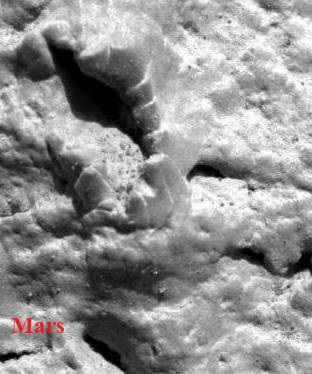
| The branching, segmenting, flat-faced triangular crotch, cup or "crown" structure enclosing something granular, all likewise arranged and similar in size, make a convincing match. (The blunted spearpoint is also noteworthy.)
| 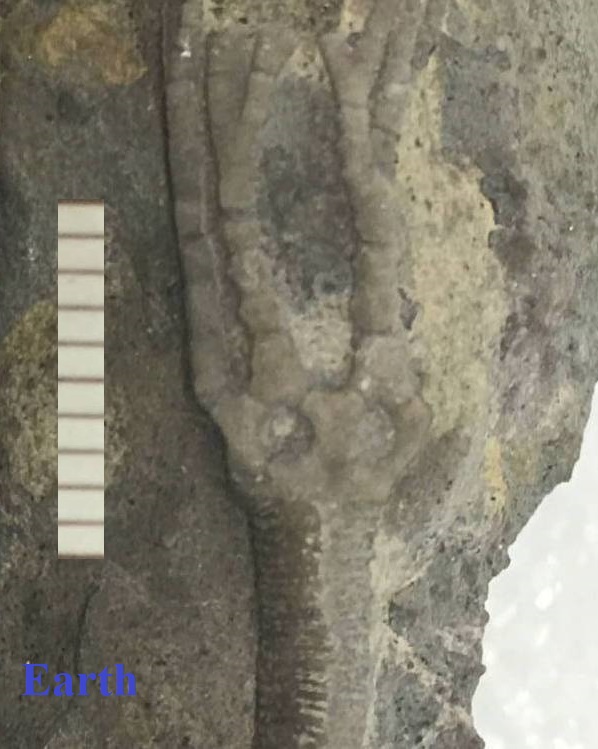
|
 Source image from NASA [link expired | local copy | with pointers], field of view: 3cm x 3cm. Source image from NASA [link expired | local copy | with pointers], field of view: 3cm x 3cm.
 Thanks, Richard B. Hoover, for this one and a reference photo from the Harvard Museum of Comparative Zoology. Thanks, Richard B. Hoover, for this one and a reference photo from the Harvard Museum of Comparative Zoology.
|
| 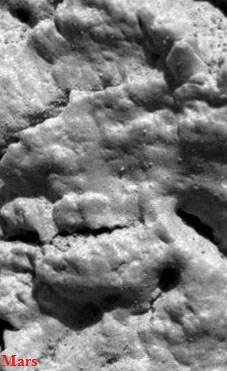
| Left: The same NASA image from Mars has another noteworthy feature (cropped field of view ∼ 6 x 12 mm). The wide shape at the bottom looks like the "calyx" or platform under the crown of the crinoid – with a deep horizontal crack above it. A smaller crack below it disconnects the calyx from its stem. The Mars image is cropped from the same NASA photo on Sol 034 [link expired | local copy with pointers], field of view: 3cm x 3cm.
Right: The crown, calyx and stem are typical of crinoids like the fossilized one from Earth (cropped from Fossilera.com - scroll down about 3 screens, similar scale.)
| 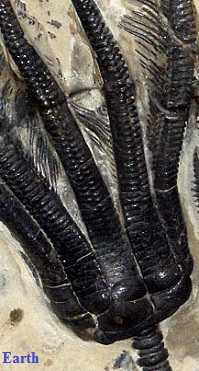
|
 Evidence from Opportunity's Microscopic Imager for Water on Meridiani Planum [local PDF], by K. E. Herkenhoff, S. W. Squyres et al., doi:10.1126/science.1105286, Science, 03 Dec 2004. This article includes NASA images before and after the RAT abrasion. The entire legend for the former reads, "Merge of three MI images (1M131201538 to 1M131201699) of target King2 on Guadalupe, taken on sol 34 before RAT abrasion. Illumination is from the top, and the area shown is 3 cm across." Evidence from Opportunity's Microscopic Imager for Water on Meridiani Planum [local PDF], by K. E. Herkenhoff, S. W. Squyres et al., doi:10.1126/science.1105286, Science, 03 Dec 2004. This article includes NASA images before and after the RAT abrasion. The entire legend for the former reads, "Merge of three MI images (1M131201538 to 1M131201699) of target King2 on Guadalupe, taken on sol 34 before RAT abrasion. Illumination is from the top, and the area shown is 3 cm across."
 Thanks for the full article, Sarah Stewart Johnson and Alan Lightman. Thanks for the full article, Sarah Stewart Johnson and Alan Lightman.
 Life on Mars! has history and updates. Life on Mars! has history and updates.
— What'sNEW —
 3D interactive image of the crinoid fossil, by Amine Belkessam on Sketchfab. 3D interactive image of the crinoid fossil, by Amine Belkessam on Sketchfab.
 06 Feb 2024: To see what is in front of one's nose needs a constant struggle — George Orwell. 06 Feb 2024: To see what is in front of one's nose needs a constant struggle — George Orwell.
 09 Jan 2024: A Brief History of Earth, by Andrew H. Knoll, Custom House, 27 Apr 2021. 09 Jan 2024: A Brief History of Earth, by Andrew H. Knoll, Custom House, 27 Apr 2021.
 Sea Lilies on Ancient Mars pdf | docx. This two-page paper was prepared for presentation at the SSoCIA conference in Oxford MS, 26-29 Mar 2020. The meeting was cancelled because of the coronavirus pandemic. Sea Lilies on Ancient Mars pdf | docx. This two-page paper was prepared for presentation at the SSoCIA conference in Oxford MS, 26-29 Mar 2020. The meeting was cancelled because of the coronavirus pandemic.
|
 Opportunity:Microscopic Imager:Sol 029: [NASA link expired | local copy | with pointer]. This example shows a blueberry on Mars with a seam like a peach has. Opportunity:Microscopic Imager:Sol 029: [NASA link expired | local copy | with pointer]. This example shows a blueberry on Mars with a seam like a peach has.
 03 Jun 2017: ...an ancient, habitable lake environment ...for tens of thousands to tens of millions of years.... 03 Jun 2017: ...an ancient, habitable lake environment ...for tens of thousands to tens of millions of years....
 Evidence for Extinct Life on Mars by Richard B. Hoover, 2015. See section 3.3, p 10. Evidence for Extinct Life on Mars by Richard B. Hoover, 2015. See section 3.3, p 10.
 26 Jul 2013: Did NASA's Opportunity rover find evidence for life...? 26 Jul 2013: Did NASA's Opportunity rover find evidence for life...?
 09 Dec 2013: ...An ancient Martian lake ...could have supported life as we know it for long stretches.... 09 Dec 2013: ...An ancient Martian lake ...could have supported life as we know it for long stretches....
— We have polled various experts for their opinions —
 The Senior Astronomer at SETI comments: geologists say the fossil is not biological, 13-15 Dec 2015. The Senior Astronomer at SETI comments: geologists say the fossil is not biological, 13-15 Dec 2015.
 Astrobiologist and Mars specialist Frances Westall writes, 'look-alikes' is not enough, 15 Jun 2016. Astrobiologist and Mars specialist Frances Westall writes, 'look-alikes' is not enough, 15 Jun 2016.
 A geologist who works with NASA on Mars missions writes, "...It could be a fabric related to recrystallization of the sulfate minerals," 4 Oct 2016. A geologist who works with NASA on Mars missions writes, "...It could be a fabric related to recrystallization of the sulfate minerals," 4 Oct 2016.
 A senior astrobiologist at NASA writes, "looking like something is different from being something," 19 Jan 2018. A senior astrobiologist at NASA writes, "looking like something is different from being something," 19 Jan 2018.
 An astrobiologist at NASA specializing in the criteria for recognizing life says life must be "the only plausible explanation," 23 Jan 2018. (What else is plausible?) An astrobiologist at NASA specializing in the criteria for recognizing life says life must be "the only plausible explanation," 23 Jan 2018. (What else is plausible?)
 NASA's website image and caption for "page not found" — No life found here. NASA's website image and caption for "page not found" — No life found here.
 Some members of The Fossil Forum (registration required) opined, "...echinoderm pieces" (the phylum for crinoids). But after discovering the Mars connection, the moderator concluded, "Mineralization, erosion, heat/pressure, impact, etc., just to name a few geological processes that might result in creating certain shapes. Ockham's Razor," 23-24 May 2018. Some members of The Fossil Forum (registration required) opined, "...echinoderm pieces" (the phylum for crinoids). But after discovering the Mars connection, the moderator concluded, "Mineralization, erosion, heat/pressure, impact, etc., just to name a few geological processes that might result in creating certain shapes. Ockham's Razor," 23-24 May 2018.
 Svetlana Shkolyar, who investigates life on Mars at the Carnegie Geophysical Laboratory, says, "My first explanation would be the phenomenon called pareidolia. ...A photo is not sufficient evidence of a biosignature," 21-23 Nov 2018. Svetlana Shkolyar, who investigates life on Mars at the Carnegie Geophysical Laboratory, says, "My first explanation would be the phenomenon called pareidolia. ...A photo is not sufficient evidence of a biosignature," 21-23 Nov 2018.
 Sea Lilies on Ancient Mars pdf. I sent this poster to The Fossil Forum. They blacklisted me, May 2020. Sea Lilies on Ancient Mars pdf. I sent this poster to The Fossil Forum. They blacklisted me, May 2020.
 My entry about the Mars fossil on the Discussion link from the APOD webpage "2020: Life in the Universe Debate" elicited this response: A ban has been issued on your IP address, Sep 2020. My entry about the Mars fossil on the Discussion link from the APOD webpage "2020: Life in the Universe Debate" elicited this response: A ban has been issued on your IP address, Sep 2020.
 A paleontologist at Monash University, Australia, said, "These look very interesting, but to tell you the real truth, I would have to see the real specimens. So, next time they go there (ha,ha) bring me back some sample...." Oct 2020. A paleontologist at Monash University, Australia, said, "These look very interesting, but to tell you the real truth, I would have to see the real specimens. So, next time they go there (ha,ha) bring me back some sample...." Oct 2020.
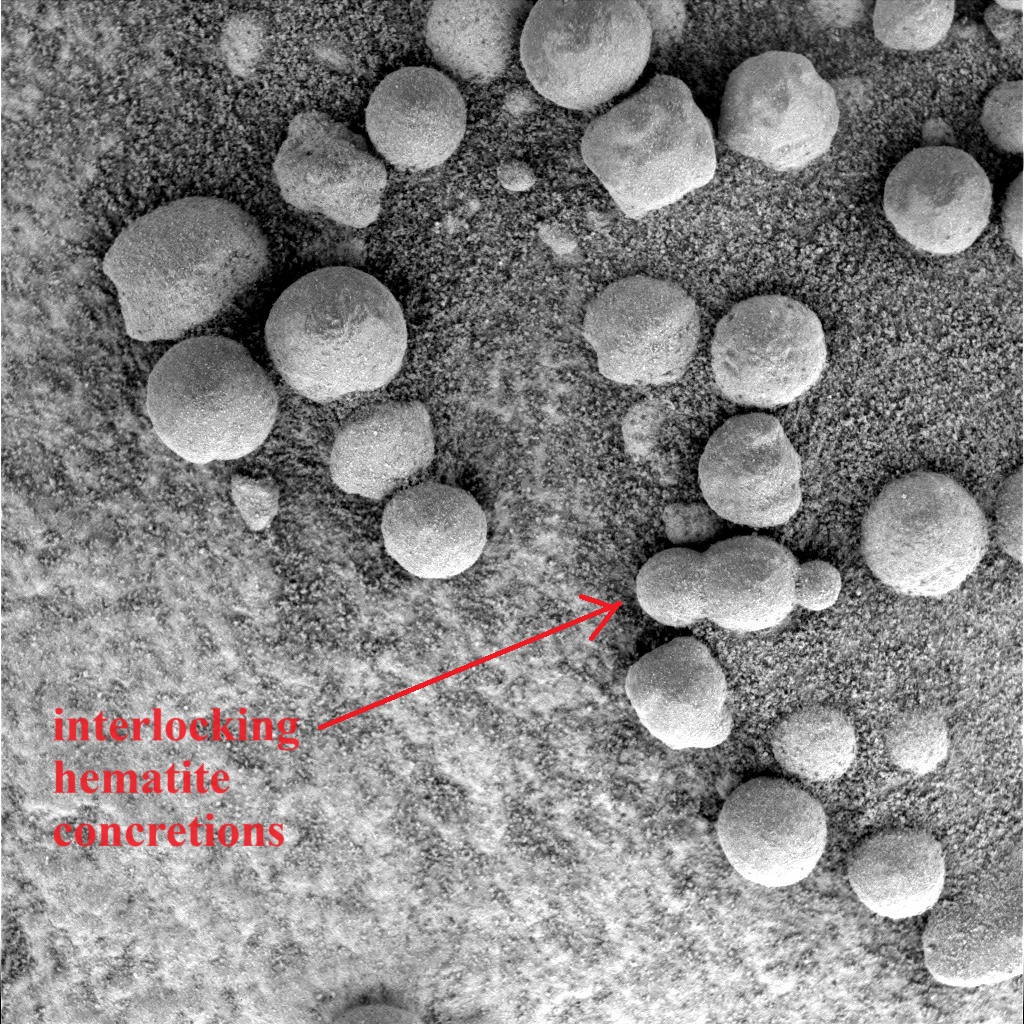
 A NASA Mars expert says, "A simpler explanation is that these features are the product of wind abrasion of the surface of a rock with an internal texture and structure that leads the rock to disintegrate in mm-size granules." Aug 2021. A NASA Mars expert says, "A simpler explanation is that these features are the product of wind abrasion of the surface of a rock with an internal texture and structure that leads the rock to disintegrate in mm-size granules." Aug 2021.
 27 Nov 2021: Fossil expert Richard Keyes agrees, it closely resembles a crinoid. 27 Nov 2021: Fossil expert Richard Keyes agrees, it closely resembles a crinoid.
 By contrast, evidence for an Earthly fossil is accepted without reservation and compared to artwork made, post facto, to resemble it: a fossil of the earliest-known member of the cnidarian group, F.S. Dunn et al., Nature Ecology & Evolution, 25 Jul 2022. By contrast, evidence for an Earthly fossil is accepted without reservation and compared to artwork made, post facto, to resemble it: a fossil of the earliest-known member of the cnidarian group, F.S. Dunn et al., Nature Ecology & Evolution, 25 Jul 2022.
 06 Feb 2024: A distinguished former member of the Opportunity science team says the fossils "could be interlocking hematite concretions; such things are observed regularly in Eagle crater...." (his example, right.) 06 Feb 2024: A distinguished former member of the Opportunity science team says the fossils "could be interlocking hematite concretions; such things are observed regularly in Eagle crater...." (his example, right.)
 A Harvard astrobiologist does "not buy the argument...because of their context, i.e. the rock(s) they are seen in," 07 Feb 2024. A Harvard astrobiologist does "not buy the argument...because of their context, i.e. the rock(s) they are seen in," 07 Feb 2024.
...It seems that Europa's ice has been penetrated often in the past, and possibly in geologically recent time.... Astrobiological materials could be transported to the ocean via these impact-created conduits.

 Impact breaching of Europa's ice: Constraints from numerical modeling, by Rónadh Cox and Aaron W. Bauer, doi:10.1002/2015JE004877, Journal of Geophysical Research, 14 Oct 2015. Impact breaching of Europa's ice: Constraints from numerical modeling, by Rónadh Cox and Aaron W. Bauer, doi:10.1002/2015JE004877, Journal of Geophysical Research, 14 Oct 2015.
 Did Comets Spark Alien Life in Europa's Oceans? by Larry O'Hanlon, Discovery.com (+Space.com), 14 Oct 2015. Did Comets Spark Alien Life in Europa's Oceans? by Larry O'Hanlon, Discovery.com (+Space.com), 14 Oct 2015.
 Thanks, Ronnie McGhee. Thanks, Ronnie McGhee.
 Life on Europa, Other Moons, Other Planets?... has links to more about possible life elsewhere. Life on Europa, Other Moons, Other Planets?... has links to more about possible life elsewhere.
Carbon isotopes that may point to life have been found in 4.1 billion-year-old zircon. The geochemists who report the finding say that the subject inclusions are likely not contaminants, and the isotopic fractionation is consistent with a biogenic origin and may be evidence that a terrestrial biosphere had emerged by 4.1 Ga, or ∼300 My earlier than has been previously proposed. Life so early would be well-explained by panspermia. Life on Earth may have started almost instantaneously, says coauthor Mark Harrison of UCLA.
 Potentially biogenic carbon preserved in a 4.1 billion-year-old zircon, by Elizabeth A. Bell et al., doi:10.1073/pnas.1517557112, PNAS, online 19 Oct 2015. Potentially biogenic carbon preserved in a 4.1 billion-year-old zircon, by Elizabeth A. Bell et al., doi:10.1073/pnas.1517557112, PNAS, online 19 Oct 2015.
 Scientists may have found the earliest evidence of life on Earth by Julia Rosen, Science, 19 Oct 2015. Scientists may have found the earliest evidence of life on Earth by Julia Rosen, Science, 19 Oct 2015.
 Life on Earth likely started 4.1 billion years ago by Stuart Wolpert, UCLA (+SpaceDaily +Physorg.com), 19 Oct 2015. Life on Earth likely started 4.1 billion years ago by Stuart Wolpert, UCLA (+SpaceDaily +Physorg.com), 19 Oct 2015.
 Life on Earth May Have Started Almost Instantaneously, The Daily Galaxy, 21 Oct 2015. Life on Earth May Have Started Almost Instantaneously, The Daily Galaxy, 21 Oct 2015.
 Thanks, Ronnie McGhee, Rob Sheldon and Stan Franklin. Thanks, Ronnie McGhee, Rob Sheldon and Stan Franklin.
 Life Before 3850 Million Years Ago? and Life Before 3850 Million Years Ago? and  The RNA World are related local webages. The RNA World are related local webages.
Neo-Darwinism just needs to be left behind so that the universe of learning, of finding out about nature, opens up properly — Mae-Wan Ho [interviewed in]
 The Paradigm Shifters: Overthrowing the 'Hegemony of the Culture of Darwin', by Suzan Mazur, Caswell Books, 17 Nov 2015. The Paradigm Shifters: Overthrowing the 'Hegemony of the Culture of Darwin', by Suzan Mazur, Caswell Books, 17 Nov 2015.
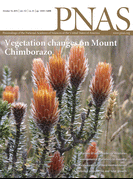 Algal ancestor of land plants was preadapted for symbiosis. That's the title of an open-access article by an international collaboration of geneticists, microbiologists and affiliated specialists. They write, The ability of the first land plants to form symbiotic associations with beneficial fungi was [a] critical innovation.... Yet they conclude that genes essential for this symbiosis predated the first land plants. It's another example of genes that appear to be available before they are needed. Standard darwinism must invent new stories to explain them. Cosmic ancestry requires them.
Algal ancestor of land plants was preadapted for symbiosis. That's the title of an open-access article by an international collaboration of geneticists, microbiologists and affiliated specialists. They write, The ability of the first land plants to form symbiotic associations with beneficial fungi was [a] critical innovation.... Yet they conclude that genes essential for this symbiosis predated the first land plants. It's another example of genes that appear to be available before they are needed. Standard darwinism must invent new stories to explain them. Cosmic ancestry requires them.
 Algal ancestor of land plants was preadapted for symbiosis by Pierre-Marc Delaux et al., doi:10.1073/pnas.1515426112, PNAS, online 5 Oct 2015. Algal ancestor of land plants was preadapted for symbiosis by Pierre-Marc Delaux et al., doi:10.1073/pnas.1515426112, PNAS, online 5 Oct 2015.
 Thanks, Sascha Wageringel, for alerts and encouragement. Thanks, Sascha Wageringel, for alerts and encouragement.
 Metazoan Genes Older Than Metazoa? and Metazoan Genes Older Than Metazoa? and  Genes Older Than Earth? are related CA webpages. Genes Older Than Earth? are related CA webpages.
 Pierre-Marc Delaux, lead author, disagrees with our comments, 23 Oct 2015. Pierre-Marc Delaux, lead author, disagrees with our comments, 23 Oct 2015.
A 500-year experiment to monitor bacterial dormancy is launched in Edinburgh and London.
 Suspended animation by Alex Riley, Aeon, 15 Oct 2015. Suspended animation by Alex Riley, Aeon, 15 Oct 2015.
 Thanks, George Nickas. Thanks, George Nickas.
 Bacteria: The Space Colonists is a related CA webpage. Bacteria: The Space Colonists is a related CA webpage.
| 9 Oct 2015 |
What'sNEW about HGT  | | |
"...Comparative analysis of eukaryotic cells and genomes indicates that the signature advanced functional systems of the eukaryotic cells were already present in the last eukaryotic common ancestor (LECA).
"...The emergence of these fundamental facets of advanced cellular organization presents a challenge of such scale that Darwin's famous scenario for the evolution of the eye looks like a straightforward solution to an easy problem.
"...the only consistent characterization of the evolutionary status of eukaryotes is as archaeo-bacterial chimeras.
"...It turns out that the evolutionary relationship between archaea and eukaryotes is not limited to the core of information-processing systems but also involves several genes and entire gene suites that are essential for eukaryotic intracellular organization. Surprisingly, however, these homologs of the signature eukaryotic genes are scattered among different archaea.
 "...The newly achieved clarity in our understanding of these key aspects of eukaryogenesis calls for reassessment of some of the most general concepts in biology. The first one is the representation of the entire history of life as a single evolutionary tree...."
"...The newly achieved clarity in our understanding of these key aspects of eukaryogenesis calls for reassessment of some of the most general concepts in biology. The first one is the representation of the entire history of life as a single evolutionary tree...."
 Eugene V. Koonin, Archaeal ancestors of eukaryotes: not so elusive any more, doi:10.1186/s12915-015-0194-5, 13:84 BMC Biology, 5 Oct 2015. Eugene V. Koonin, Archaeal ancestors of eukaryotes: not so elusive any more, doi:10.1186/s12915-015-0194-5, 13:84 BMC Biology, 5 Oct 2015.
 Thanks, Martin Langford. And Stan Franklin. Thanks, Martin Langford. And Stan Franklin.
|
We agree and we thank NIH's Eugene V. Koonin for his insights. But something troubles us. In this article the term "origin" appears about 40 times overall. The meta-message is that now, with previously unknown origins revealed, the workings of neo-darwinism are being sustained in detail. But wait. If something originated, that would mean that it did not already exist. Yet Koonin explains that the genes for most eukaryotic systems were "already present." The term "origin" seems to have a different meaning in the darwinian paradigm, something like "proof of prior existence." Actually, no "origin" has been revealed in this analysis.
Eukaryotic genes that exist before eukaryotes confound standard darwinism and confirm cosmic ancestry.
|
 The Tree of Life, The Tree of Life,  Metazoan Genes Older Than Metazoa? and Metazoan Genes Older Than Metazoa? and
 Genes Older Than Earth? are related CA webpages. Genes Older Than Earth? are related CA webpages.
 Numerous genes for Eukaryotic Signature Proteins (ESPs) have been found in Archaea, What'sNEW, 7 May 2015. Numerous genes for Eukaryotic Signature Proteins (ESPs) have been found in Archaea, What'sNEW, 7 May 2015.
 Viruses and Other Gene Transfer Mechanisms is a related CA webpage. Viruses and Other Gene Transfer Mechanisms is a related CA webpage.
 There is water on Mars! This is the latest news from NASA. Alfred S. McEwen, professor of planetary geology at the University of Arizona and the principal investigator of images from a high-resolution camera on the Mars Reconnaissance Orbiter, reports the detection of hydration salts in dark streaks on slopes on Mars. These must have formed in the presence of liquid water within only days before their detection. This evidence supports the earlier suggestion that recurring dark streaks on Mars are traces of flowing water. (NASA's computer-generated false-color Mars image here exaggerates the vertical dimension by 1.5x.)
There is water on Mars! This is the latest news from NASA. Alfred S. McEwen, professor of planetary geology at the University of Arizona and the principal investigator of images from a high-resolution camera on the Mars Reconnaissance Orbiter, reports the detection of hydration salts in dark streaks on slopes on Mars. These must have formed in the presence of liquid water within only days before their detection. This evidence supports the earlier suggestion that recurring dark streaks on Mars are traces of flowing water. (NASA's computer-generated false-color Mars image here exaggerates the vertical dimension by 1.5x.)
 Life on Mars! includes links to c. 75 earlier reports of water on Mars. Search the page for "water" or "ocean". Life on Mars! includes links to c. 75 earlier reports of water on Mars. Search the page for "water" or "ocean".
 NASA Confirms Evidence That Liquid Water Flows on Today's Mars, NASA, 28 Sep 2015. NASA Confirms Evidence That Liquid Water Flows on Today's Mars, NASA, 28 Sep 2015.
 Signs of Liquid Water Found on Surface of Mars... by Kenneth Chang, The New York Times, 28 Sep 2015. Signs of Liquid Water Found on Surface of Mars... by Kenneth Chang, The New York Times, 28 Sep 2015.
 Martian salt streaks 'painted by liquid water' by Jonathan Amos, BBC News, 28 Sep 2015. Martian salt streaks 'painted by liquid water' by Jonathan Amos, BBC News, 28 Sep 2015.
 Thanks, Polly Klyce Pennoyer, Richard Hoover, Martin Langford and NPR. Thanks, Polly Klyce Pennoyer, Richard Hoover, Martin Langford and NPR.
 Seasonal Streaks Point to Recent Flowing Water on Mars, Astronomy Picture of the Day, 30 Sep 2015. Seasonal Streaks Point to Recent Flowing Water on Mars, Astronomy Picture of the Day, 30 Sep 2015.
 Mars find suggests our solar system is awash with life by Chandra Wickramasinghe, The Guardian, 30 Sep 2015. Mars find suggests our solar system is awash with life by Chandra Wickramasinghe, The Guardian, 30 Sep 2015.
 Chandra Wickramasinghe sends a copy of his letter "Life on Mars," published in The Times, 2 Oct 2015. Chandra Wickramasinghe sends a copy of his letter "Life on Mars," published in The Times, 2 Oct 2015.
 Neil deGrasse Tyson – Water on Mars: 6-min. YouTube video with Bill Maher, 2 Oct 2015. Neil deGrasse Tyson – Water on Mars: 6-min. YouTube video with Bill Maher, 2 Oct 2015.
 Thanks, Justin Willingham. Thanks, Justin Willingham.
| 27 Sep 2015 |
What'sNEW about HGT  | | |
Nearly 65% of the proteins encoded by Mollivirus have no known homologs. So says Barbara R. Jasny in commentary on the report of a newly observed giant virus whose genome encodes 523 proteins. In addition to the majority of unfamilar genes, 16% have homologs in another giant virus, and 10% have homologs in the virus's usual host. Intriguingly, the virus remains viable after 30,000 years in Siberian permafrost.
Genes without discernable provenence, genes where they aren't needed, genes acquired by horizontal transfer, and frozen giant viruses that can persist without apparent limit? All of this surprises standard darwinism and supports cosmic ancestry.
 In-depth study of Mollivirus sibericum, a new 30,000-y-old giant virus infecting Acanthamoeba by Matthieu Legendre, Audrey Lartigue et al., doi:10.1073/pnas.1510795112, E5327–E5335, n 38 v 112, PNAS, 22 Sep 2015. In-depth study of Mollivirus sibericum, a new 30,000-y-old giant virus infecting Acanthamoeba by Matthieu Legendre, Audrey Lartigue et al., doi:10.1073/pnas.1510795112, E5327–E5335, n 38 v 112, PNAS, 22 Sep 2015.
 Giant virus varieties keep growing by Barbara R. Jasny, doi:10.1126/science.349.6255.1501-e, Science, 25 Sep 2015. Giant virus varieties keep growing by Barbara R. Jasny, doi:10.1126/science.349.6255.1501-e, Science, 25 Sep 2015.
 Viruses and Other Gene Transfer Mechanisms is a related local webpage. Viruses and Other Gene Transfer Mechanisms is a related local webpage.
 Robert Temple
alerts us to related earlier research by the same French team, 11 Sep 2015. Robert Temple
alerts us to related earlier research by the same French team, 11 Sep 2015.
| 24 Sep 2015 |
What'sNEW about HGT  | | |
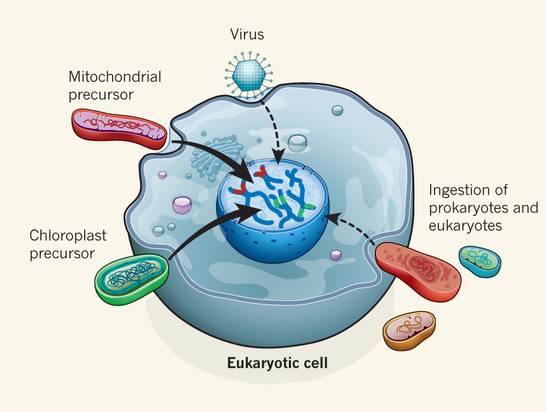 The nuclear genome is an ever-evolving mosaic of DNA acquired from different sources
— John M. Archibald
The nuclear genome is an ever-evolving mosaic of DNA acquired from different sources
— John M. Archibald
 Gene transfer in complex cells, Archibald's commentary on: Gene transfer in complex cells, Archibald's commentary on:
 Endosymbiotic origin and differential loss of eukaryotic genes by Chuan Ku et al., doi:10.1038/nature14963, v 524, Nature, 27 Aug 2015. Endosymbiotic origin and differential loss of eukaryotic genes by Chuan Ku et al., doi:10.1038/nature14963, v 524, Nature, 27 Aug 2015.
 Viruses and Other Gene Transfer Mechanisms is a related local webpage. Viruses and Other Gene Transfer Mechanisms is a related local webpage.
| 15 Sep 2015 |
What'sNEW about HGT  | | |
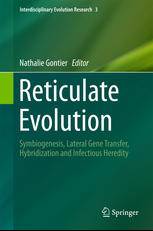 The abundant occurance of lateral gene transfer in all three domains of life has only been recognized in recent years. Molecular phylogenetic reconstructions ...now provide conclusive evidence for "alien" or exogenous DNA uptake....
The abundant occurance of lateral gene transfer in all three domains of life has only been recognized in recent years. Molecular phylogenetic reconstructions ...now provide conclusive evidence for "alien" or exogenous DNA uptake....
 Nathalie Gontier, ed., Reticulate Evolution, v 3, Interdisciplinary Evolution Research, ISBN:978-3-319-16344-4, Springer International Publishing, 10 Jul 2015. Nathalie Gontier, ed., Reticulate Evolution, v 3, Interdisciplinary Evolution Research, ISBN:978-3-319-16344-4, Springer International Publishing, 10 Jul 2015.
 Thanks, Stan Franklin, for mentioning this book. Thanks, Stan Franklin, for mentioning this book.
 Viruses... is a related local webpage. Viruses... is a related local webpage.
 Book Reviews Book Reviews
 30,000-year-old giant virus 'comes back to life' by Rebecca Morelle, BBC News, 4 Mar 2014. 30,000-year-old giant virus 'comes back to life' by Rebecca Morelle, BBC News, 4 Mar 2014.
 Thanks, Robert Temple. Thanks, Robert Temple.
 New Pluto Images from NASA's New Horizons: It's Complicated, NASA, 10 Sep 2015. New Pluto Images from NASA's New Horizons: It's Complicated, NASA, 10 Sep 2015.
 Thanks, Lawrence Klaes. Thanks, Lawrence Klaes.
 Remnants of Life Found Half a Mile Below the Seafloor by Dirk Schulze-Makuch, Air & Space, 9 Sep 2015. "Similar deep habitats might be found on other worlds." Remnants of Life Found Half a Mile Below the Seafloor by Dirk Schulze-Makuch, Air & Space, 9 Sep 2015. "Similar deep habitats might be found on other worlds."
 Thanks, Bill Smith. Thanks, Bill Smith.
 Wallis MK and Wickramasinghe NC, "Pluto's Surprises: Mountain Tectonics, Methane and Evidence of Biology," doi:10.4172/2332-2519.1000135, Journal of Astrobiology & Outreach, 27 Jul 2015. Wallis MK and Wickramasinghe NC, "Pluto's Surprises: Mountain Tectonics, Methane and Evidence of Biology," doi:10.4172/2332-2519.1000135, Journal of Astrobiology & Outreach, 27 Jul 2015.
We have found thousands of transcripts that are human- and/or chimpanzee-specific and which are likely to have originated de novo from previously non-transcribed regions of the genome. We have observed an enrichment in transcription factor binding sites in the promoter regions of these genes.... [S]ome of the genes encode new functional proteins ...which may have contributed to phenotypic novelties in human evolution. These are among the observations made by European researchers in genomics and related specialties who analyzed RNA sequence data from humans, chimps and other species. They undertook the study because they believe, as they state at the outset, The birth of new genes is an important motor of evolutionary innovation.
They saw that many important genes were formerly silent, open reading frames (ORFs) that were recruited into service by newly acquired promoter sequences. This phenomenon is becoming well-known, and the previously silent ORFs are now designated de novo genes. They comment, ...In de novo gene evolution the full sequence space can be potentially explored....
Yes, theoretically. But not in the real world. Even a gene of only 300 nucleotides has 4^300 or about 10^180 possibilities in its sequence space. Allowing for very wide (very wide) latitude in the protein product, the exponent might be effectively halved; even so, ∼10^90 possibilities? A sequence space that large to fully explore? For more than two thousand de novo genes? The entire human genome has room for only about 10^7 such sequences. Where on Earth would this exploration be taking place? Where at all?
The "birth" of new genes is not an observed phenomenon. We only call them "new" because they were first observed or first activated in the species under study. It would be more fruitful to ask where the genes come from, how they got here, etc., as in cosmic ancestry.
 Jorge Ruiz-Orera et al., "Origins of de novo genes in human and chimpanzee," arXiv:1507.07744 [q-bio.GN], 28 Jul 2015. Jorge Ruiz-Orera et al., "Origins of de novo genes in human and chimpanzee," arXiv:1507.07744 [q-bio.GN], 28 Jul 2015.
 A Surprise Source of Life's Code by Emily Singer, Quanta Magazine (+Scientific American), 18 Aug 2015.
Emerging data suggests the seemingly impossible – that mysterious new genes arise from "junk" DNA. A Surprise Source of Life's Code by Emily Singer, Quanta Magazine (+Scientific American), 18 Aug 2015.
Emerging data suggests the seemingly impossible – that mysterious new genes arise from "junk" DNA.
 Conserved Non-Genic Sequences, Conserved Non-Genic Sequences,  A Wordcount for Comparison, A Wordcount for Comparison,
 Three New Human Genes, Three New Human Genes,  New genetic programs in Darwinism and strong panspermia, New genetic programs in Darwinism and strong panspermia,
 Human Genome Search and Human Genome Search and  Neo-Darwinism... are related CA webpages. Neo-Darwinism... are related CA webpages.
 Thanks, Ken Jopp! Thanks, Ken Jopp!
 04 Jan 2016: We discuss a new version of Ruiz-Orera et al., published in PLoS, 31 Dec 2015. 04 Jan 2016: We discuss a new version of Ruiz-Orera et al., published in PLoS, 31 Dec 2015.
![]()
|
 Mainstream science cannot explain the abundant O2 in the atmosphere of comet 67P. Instruments on ESA's Rosetta spacecraft detected the oxygen consistently over months of observation. Current Solar System formation models do not predict conditions that would allow this to occur.
Mainstream science cannot explain the abundant O2 in the atmosphere of comet 67P. Instruments on ESA's Rosetta spacecraft detected the oxygen consistently over months of observation. Current Solar System formation models do not predict conditions that would allow this to occur.
 Algal ancestor of land plants was preadapted for symbiosis. That's the title of an open-access article by an international collaboration of geneticists, microbiologists and affiliated specialists. They write, The ability of the first land plants to form symbiotic associations with beneficial fungi was [a] critical innovation.... Yet they conclude that genes essential for this symbiosis predated the first land plants. It's another example of genes that appear to be available before they are needed. Standard darwinism must invent new stories to explain them. Cosmic ancestry requires them.
Algal ancestor of land plants was preadapted for symbiosis. That's the title of an open-access article by an international collaboration of geneticists, microbiologists and affiliated specialists. They write, The ability of the first land plants to form symbiotic associations with beneficial fungi was [a] critical innovation.... Yet they conclude that genes essential for this symbiosis predated the first land plants. It's another example of genes that appear to be available before they are needed. Standard darwinism must invent new stories to explain them. Cosmic ancestry requires them.
 "...The newly achieved clarity in our understanding of these key aspects of eukaryogenesis calls for reassessment of some of the most general concepts in biology. The first one is the representation of the entire history of life as a single evolutionary tree...."
"...The newly achieved clarity in our understanding of these key aspects of eukaryogenesis calls for reassessment of some of the most general concepts in biology. The first one is the representation of the entire history of life as a single evolutionary tree...."
 There is water on Mars! This is the latest news from NASA. Alfred S. McEwen, professor of planetary geology at the University of Arizona and the principal investigator of images from a high-resolution camera on the Mars Reconnaissance Orbiter, reports the detection of hydration salts in dark streaks on slopes on Mars. These must have formed in the presence of liquid water within only days before their detection. This evidence supports the earlier suggestion that recurring dark streaks on Mars are traces of flowing water. (NASA's computer-generated false-color Mars image here exaggerates the vertical dimension by 1.5x.)
There is water on Mars! This is the latest news from NASA. Alfred S. McEwen, professor of planetary geology at the University of Arizona and the principal investigator of images from a high-resolution camera on the Mars Reconnaissance Orbiter, reports the detection of hydration salts in dark streaks on slopes on Mars. These must have formed in the presence of liquid water within only days before their detection. This evidence supports the earlier suggestion that recurring dark streaks on Mars are traces of flowing water. (NASA's computer-generated false-color Mars image here exaggerates the vertical dimension by 1.5x.)
 The nuclear genome is an ever-evolving mosaic of DNA acquired from different sources
— John M. Archibald
The nuclear genome is an ever-evolving mosaic of DNA acquired from different sources
— John M. Archibald
 The abundant occurance of lateral gene transfer in all three domains of life has only been recognized in recent years. Molecular phylogenetic reconstructions ...now provide conclusive evidence for "alien" or exogenous DNA uptake....
The abundant occurance of lateral gene transfer in all three domains of life has only been recognized in recent years. Molecular phylogenetic reconstructions ...now provide conclusive evidence for "alien" or exogenous DNA uptake....




